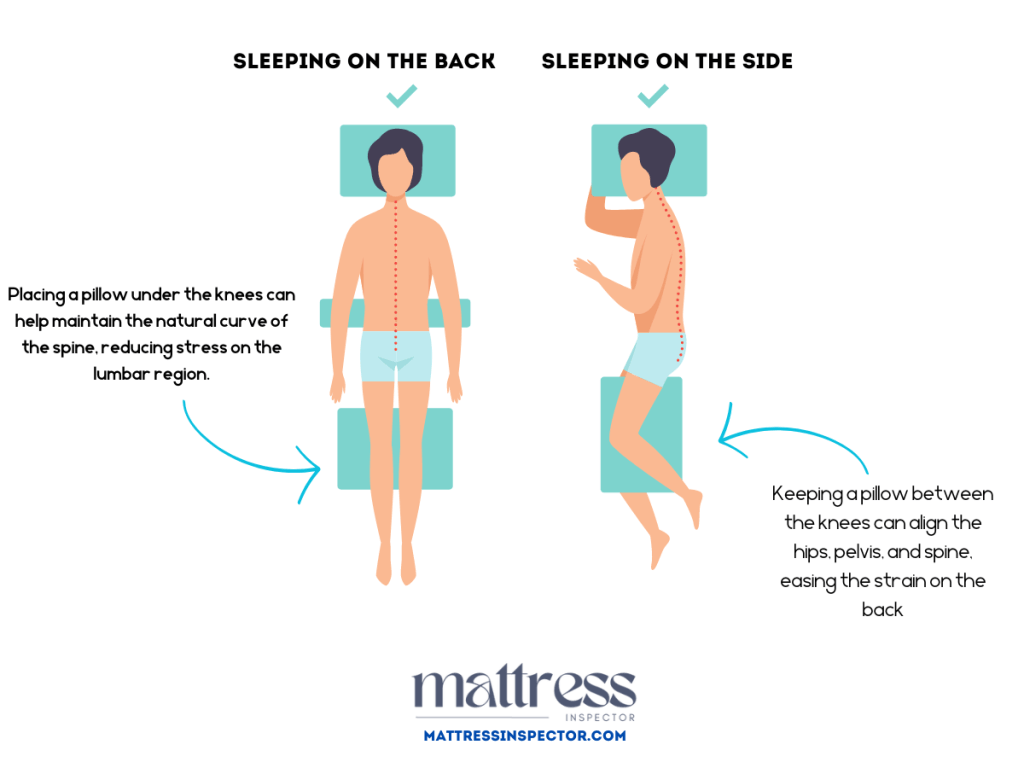Lower back pain is a common affliction affecting millions of individuals worldwide, significantly impacting daily activities and, crucially, the quality of sleep.
Characterized by discomfort ranging from mild aching to debilitating pain, lower back issues are a leading cause of disability and a frequent reason for seeking medical attention.
The intimate relationship between sleep and pain, where each influences the other, forms a vicious cycle that can be challenging to break. Poor sleep can intensify pain perception, while effective pain management can substantially improve sleep quality.
In this comprehensive exploration, we delve into various dimensions of sleeping with lower back pain.
From understanding the anatomical and physiological bases of pain to practical advice on sleep positions and the selection of appropriate bedding, this article aims to provide scientifically-backed information that offers both insight and practical help.
An essential component of managing sleep-related back pain is the choice of mattress.
As highlighted in our reference guide on Best Mattresses for Sciatica, the right mattress can play a pivotal role in alleviating pain and improving sleep quality. Here, we explore how choosing the appropriate mattress, backed by the latest research and patient feedback, can transform sleep experiences for those suffering from lower back pain.
Understanding Lower Back Pain
Lower back pain (LBP) is a complex condition with a variety of causes ranging from acute injuries to chronic degenerative diseases. To manage and mitigate LBP effectively, especially during sleep, a thorough understanding of the underlying anatomy and common conditions is essential.
Anatomy of the Lower Back
The lower back, or lumbar region, is composed of five vertebrae (L1-L5) in the spine situated between the rib cage and the pelvis.
This area supports much of the body’s weight and is involved in a wide range of movements, making it particularly susceptible to injury. The spinal cord, nerves, muscles, ligaments, and tendons all play roles in the structural support and functional capacity of the lower back.
Common Conditions Associated with Lower Back Pain
Sciatica: Characterized by pain that radiates along the path of the sciatic nerve, which extends from the lower back down to the legs. This condition is often caused by a herniated disk or a bone spur compressing the nerve.
Herniated Discs: Occurs when the soft material inside a disc escapes through a tear in the tougher exterior, irritating nearby nerves. A 2016 study published in the Journal of Physical Therapy Science found that sleep quality significantly worsens in patients with herniated discs, impacting pain levels (Park, 2016).
Spinal Stenosis: Involves the narrowing of spaces in the spine, which can compress spinal nerves and lead to pain. Research has shown that spinal stenosis can lead to persistent pain that affects sleep patterns (Mayo Clinic, 2017, Source).
The Science of Sleep and Pain
Understanding how sleep interacts with pain is crucial for managing nighttime discomfort. The relationship is bidirectional; pain can disrupt sleep, while poor sleep can increase the perception of pain.
Impact of Sleep on Pain Perception
A landmark study by the National Sleep Foundation in 2015 demonstrated that individuals who suffer from poor sleep quality report a higher sensitivity to pain, underscoring the importance of good sleep in pain management (National Sleep Foundation, 2015).
Sleep Deprivation and Inflammation
Research indicates that lack of sleep can lead to increased inflammation in the body, which in turn exacerbates pain. A 2019 study in the Journal of Experimental Medicine revealed that sleep loss can activate inflammatory pathways that worsen pain sensitivity (Kundermann et al., 2019).
Practical Sleeping Tips for Lower Back Pain
To combat lower back pain during sleep, several practical strategies can be employed, focusing on optimizing sleep positions, using supportive accessories, and incorporating lifestyle changes.
Optimal Sleep Positions

Sleeping on the back: Placing a pillow under the knees can help maintain the natural curve of the spine, reducing stress on the lumbar region.
Sleeping on the side: Keeping a pillow between the knees can align the hips, pelvis, and spine, easing the strain on the back.
Role of Pillows and Mattress
The choice of mattress and pillow is critical for those suffering from lower back pain. As referenced in the article on Best Mattresses for Sciatica, selecting a mattress that supports spinal alignment and distributes body weight evenly is essential to reduce stress on the spine and alleviate pain.
Lifestyle Modifications
Regular physical activity: Maintaining a routine of gentle exercises like walking or yoga can strengthen back muscles and improve overall spinal health.
Mindfulness and relaxation techniques: Practices such as meditation or deep-breathing exercises can help manage stress, which is often a contributor to increased pain perception.
Choosing the Right Mattress for Back Pain
The role of the mattress in managing lower back pain is significant, as it influences spinal alignment and overall sleep quality. The right mattress can help alleviate pain, while an unsuitable one may worsen it.
Impact of Mattress on Back Pain
Scientific research supports the idea that mattress firmness can affect back pain. A randomized, double-blind study conducted in 2003 published in The Lancet found that participants who used medium-firm mattresses experienced less back pain compared to those who slept on firm mattresses (Kovacs et al., 2003). This study suggests that medium firmness provides a balance of support and comfort, accommodating the natural curvature of the spine.
Types of Mattresses
Memory Foam: Adapts to the body’s shape, providing pressure relief and support. However, some models can retain heat, which may be uncomfortable for some users.
Innerspring: Offers firmer support due to the coil springs, which is beneficial for some people with back pain, though it may lack sufficient contouring for others.
Latex: Known for its durability and support, latex mattresses offer a good balance of comfort and firmness, and are also hypoallergenic and eco-friendly.
Referencing the Best Mattresses for Sciatica, it’s clear that choosing a mattress should be based on individual needs, particularly for those suffering from specific conditions like sciatica that can exacerbate lower back pain.
Tips for Selecting a Mattress
Trial Periods: Many companies offer trial periods, allowing you to test the mattress and ensure it meets your comfort needs.
Consult Healthcare Providers: For those with chronic pain, consulting with a physical therapist or chiropractor on the type of mattress that might best support their spine can be beneficial.
Check Reviews and Recommendations: Especially those from other users who have back pain issues, as found in comprehensive guides like the one on MattressInspector.
Advanced Therapies and Treatments
While lifestyle adjustments and choosing the right mattress are vital, some cases of chronic lower back pain may require advanced medical interventions.
Medical Treatments
Medications: Over-the-counter pain relievers like ibuprofen are commonly used, but in more severe cases, prescription medications, including muscle relaxants and even opioids, may be prescribed under careful medical supervision.
Physical Therapy: A cornerstone of back pain treatment, physical therapy can help strengthen muscles and improve posture, which is crucial for spinal health.
Emerging Therapies
Acupuncture: Studies, including a 2020 systematic review published in Pain Medicine, have shown that acupuncture can be effective in reducing chronic pain, including that of the lower back (Vickers et al., 2020).
Spinal Stimulation: For severe cases, electrical stimulation devices can be implanted to help manage pain by interrupting nerve signals.
Conclusion
Living with lower back pain can be challenging, particularly when it interferes with essential restorative sleep. This article has explored the anatomical and medical foundations of back pain, provided evidence-based strategies for managing pain during sleep, and discussed the critical role of selecting the right mattress.
Adapting some of the practical tips and considering both traditional and advanced treatments can significantly improve quality of life for those suffering from this condition.

